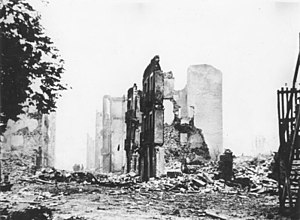Siege of San Salvador
| Siege of San Salvador | |||||||||
|---|---|---|---|---|---|---|---|---|---|
| Part of the Creeperian Civil War | |||||||||
 Ruins of San Salvador following end of the war. | |||||||||
| |||||||||
| Belligerents | |||||||||
| Commanders and leaders | |||||||||
|
|
| ||||||||
| Strength | |||||||||
|
600,000 personnel 3,300 artillery pieces 300 tanks 200 aircraft |
650,000 personnel 3,000 artillery pieces 400 tanks 150 aircraft | ||||||||
| Casualties and losses | |||||||||
|
110,000 killed or missing 234,000 wounded or sick 200 aircraft destroyed 300 tanks destroyed |
190,000 killed or missing 300,000 wounded or sick 130 aircraft destroyed 400 tanks destroyed | ||||||||
|
300,000 total killed or missing 534,000 wounded or sick | |||||||||
The Siege of San Salvador (May 17, 1946-August 30, 1949) was the largest, lengthiest, and deadliest confrontation of the Creeperian Civil War, in which the Romerists and the Miguelists fought for control of the city of San Salvador, the capital city of Creeperopolis.
The Miguelist offensive to capture San Salvador began in May 1946. The attack was supported by the Miguelist Air Force bombing that reduced much of the city to rubble. The fighting degenerated into house-to-house fighting; both sides poured reinforcements into the city to prevent the other from gaining complete control. By 1948, 60% of the city had been reduced to rubble.
In September 1948, the Romerists launched an offensive into the eastern parts of the city controlled by the Miguelists. The Miguelists stood their ground and received reinforcements. By July 1949, the Miguelists had begun to fall apart and a retreat order was given. Romero II ordered a no-quarter on Miguelist prisoners of war. The Miguelists completely withdrew out of the San Salvadoran Valley by August 30, 1949. The seige lasted three years, three months, and two weeks.
